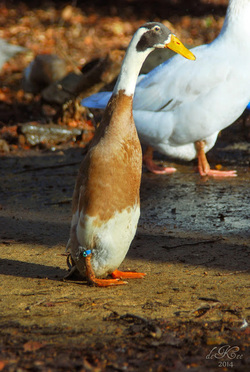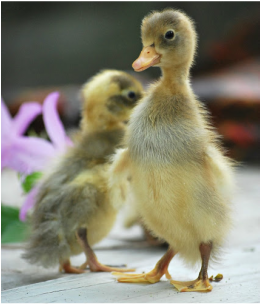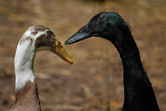All About Indian Runner Ducks

Indian Runners are an unusual looking domestic duck. An ancient breed, they’re very slender and stand upright... imagine a bowling pin with legs. This waterfowl originated in the Far East, with roots in India and Bali. Hieroglyphics depicting this upright, slender duck appear in ancient Java temple ruins indicating that Runner-type ducks have been around for over 2,000 years. They were first imported into Europe nearly two hundred years ago where they attracted attention because of their tall, upright bodies and their incredible reputation for egg-laying.
Not your average waddler... Runners are busy little bowling pins. These funny ducks never seem to walk anywhere - they’re always moving at a run. It’s not an awkward waddle, either; they’re graceful and surprisingly quick in their upright mode. These birds have an ultra-strong flocking instinct and when they move in groups, they run, turn, and sway with the coordinated precision of highly-trained synchronized swimmers.
Runners are the most active foragers of all ducks. They range over a large area eating mosquito larvae, snails, slugs, weeds, and other edibles. They don't require a pond for good health, but they do really enjoy swimming and are very graceful on the water.

These ducks are quick-growing and great layers, each hen can lay 220 - 240 white or blue eggs per year averaging 2.8 oz., which the USDA would grade it as "Jumbo"; they have a rich flavor and texture. With proper management, they will continue to lay well for 4 - 5 years. Though they are a light-class duck, Runners are a fine table bird. With their good meat to bone ratio it’s been noted that the “flesh is abundant for the size of body, fine in quality and well flavored.”
Best known for their exuberant personalities they are also widely used in cross-breeding to add heartiness and enthusiasm to more traditional table breeds. In fact, from the time they were first introduced to Western Europe in the late sixteenth century they were crossed with other domestic ducks to such an extent that the pure Indian Runners were almost extinct in Britain by the beginning of the twentieth century. They were used to create Khaki Campbells, Buff Orpingtons and the rush of 'Light Duck' breeds that now fill the commercial farms and exhibition pens.

Though they're good egg layers, Runners rarely go broody and even if they do these girls are just too air-headed to be good moms. My old girls will set a nest every year but I have to take the babies away as soon as they hatch if I want them to survive.
Like most breeds of domestic duck, Runners are a derivative of the wild mallard. Over 2000 years, most of that time in the East Asian Islands, the evolution of the breed was likely determined more by human influence than natural selection. They are distinct from other domestic ducks not only by geography but also by their shape, bone structure and blood proteins. They are a valuable breed worth preserving.
Superbly hardy ducks who are both very excitable and wonderfully social. While they're not unfriendly to people, Runners are a naturally high-strung breed that is timid but trainable. They tend to be a little on the skittish side and are very prone to panic if cornered. They will scramble over a two to three foot enclosure to flee hysterically from something that scares them... which is almost everything that doesn't look like a duck. They have a good sense of humor among the flock and tend to be a little clownish, so they're fun to watch. With proper care they'll be around to entertain themselves and you for 8 to 10 years.
The Indian Runner is listed in a "watch" status by the American Livestock Breeds Conservancy.
Like most breeds of domestic duck, Runners are a derivative of the wild mallard. Over 2000 years, most of that time in the East Asian Islands, the evolution of the breed was likely determined more by human influence than natural selection. They are distinct from other domestic ducks not only by geography but also by their shape, bone structure and blood proteins. They are a valuable breed worth preserving.
Superbly hardy ducks who are both very excitable and wonderfully social. While they're not unfriendly to people, Runners are a naturally high-strung breed that is timid but trainable. They tend to be a little on the skittish side and are very prone to panic if cornered. They will scramble over a two to three foot enclosure to flee hysterically from something that scares them... which is almost everything that doesn't look like a duck. They have a good sense of humor among the flock and tend to be a little clownish, so they're fun to watch. With proper care they'll be around to entertain themselves and you for 8 to 10 years.
The Indian Runner is listed in a "watch" status by the American Livestock Breeds Conservancy.










